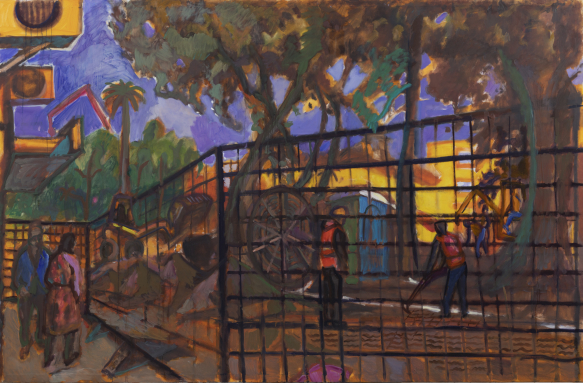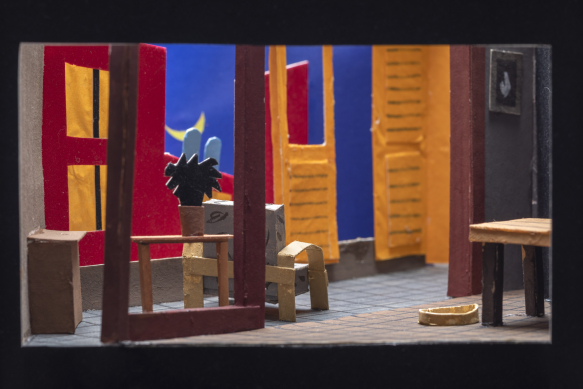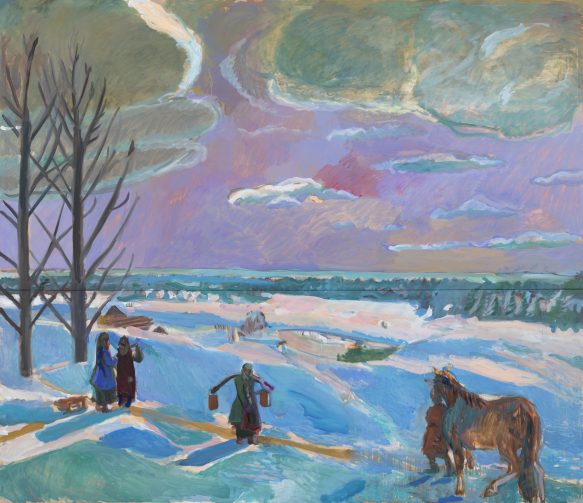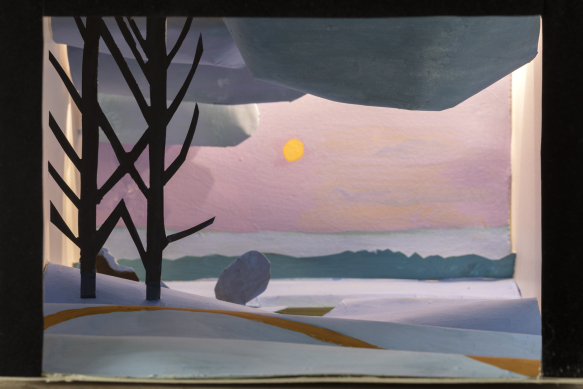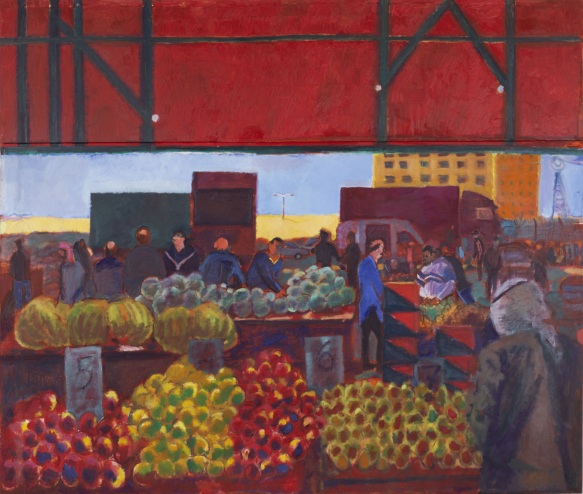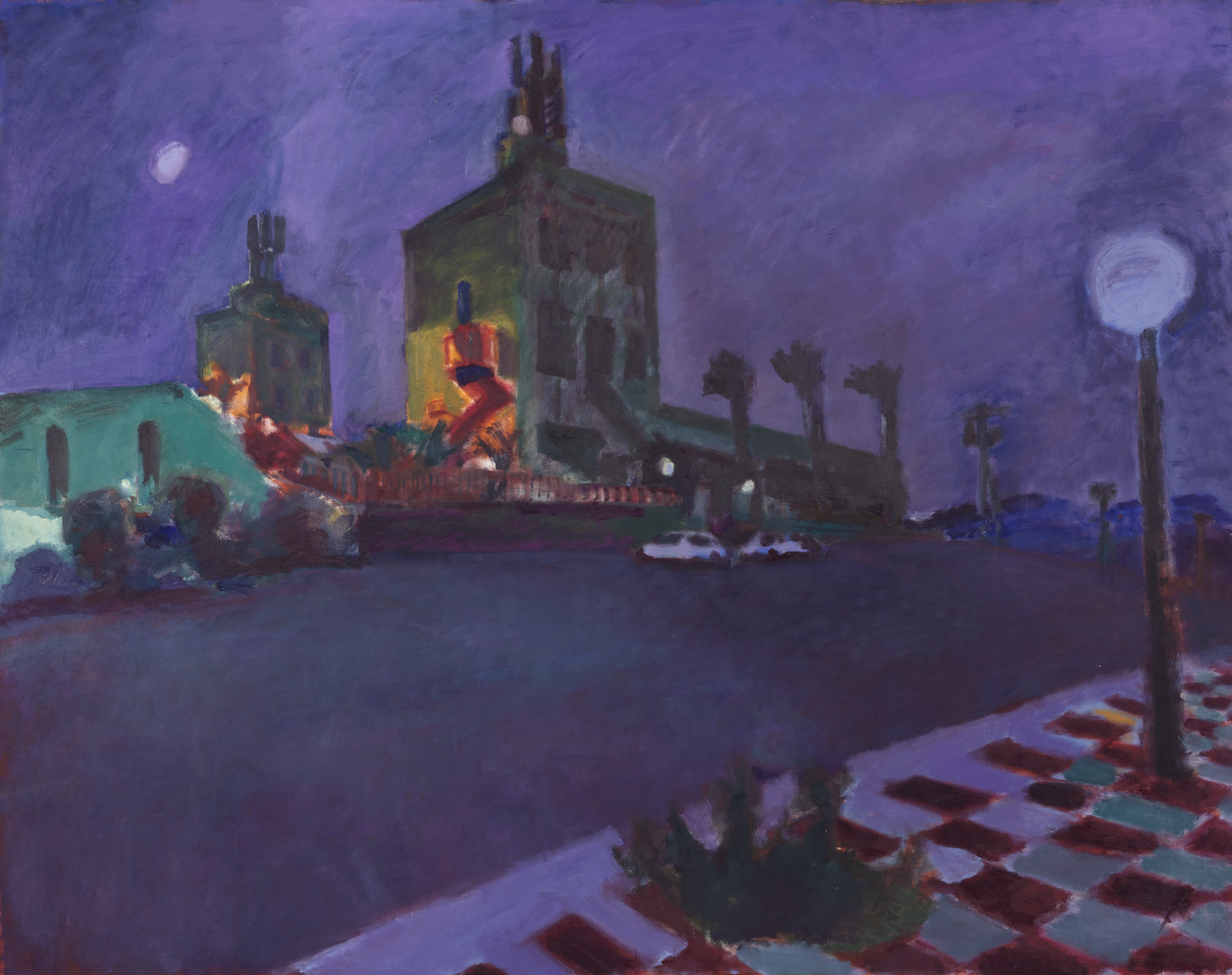“A country road. A tree. Evening.”
These three short stage directions at the opening of Samuel Beckett’s Waiting for Godot dictate the mood that dominates the entire play. A futile wait, a meaningless search. Existential absurdity that ends up as mundane absurdity.
A desert road. An abandoned hotel. Night.
Natalia Zourabova’s new works offer decor without a play; they build an atmosphere without words, providing stage directions for our existential theater. But even in the absence of words, the play has already been written. It is somewhere in our minds, partly familiar to us, like any good setting; it awakens dormant areas, elicits distant memories, touching on our collective memory. An abandoned hotel in Arad, a market full of strangers, roadworks.
The decor invites us to tell a story that we may momentarily recall, even though we are not entirely familiar with yet. Like the paintings, it originates in reality, but continues to develop in Zourabova’s imagination; continues to twist and turn in our imagination.
We have become accustomed to living in settings, so much so that we cannot always differentiate reality from the way we interpret it. We think to ourselves that it is the perfect setting: palm trees bent over the ocean are the perfect setting for a vacation; a dark candlelit castle is the perfect setting for a murder; the beach at sunset is the perfect setting for a marriage proposal; a deserted airport is the perfect setting for solitude. Scenes from movies and the theater blend with commercial sets and real memories, with the setting of life as we have experienced it.
The city of Arad serves Zourabova as the perfect setting for a broken dream. Only some of the paintings in the exhibition “Arad” were actually painted in that city, but the notion of Arad as a desert utopia inspires the entire show. Arad was established in the desert with the hope of creating a different society—a city planned in detail by architects, who built patio homes and staircases intended to correspond with the desert climate. A city that brought with it a prestigious, pioneering spirit, and attracted individuals practicing in-demand professions who were subjected to an admissions committee. Arad as a model for the Israel of our dreams.
Zourabova’s connection to Arad and the desert began some twenty years ago, when she left Europe following her heart and pursuing love, and arrived in Beer Sheva—the pearl of the desert, a city dominated by the color yellow. She dreamed of the desert while still in the Russian snow, and it recurs in her paintings and dreams even today, after more than a decade in Jaffa. The wilderness yellow integrates into the monumental paintings, into the settings of life. It is in the background of the light rail works on Jaffa’s Jerusalem Blvd; it peeks out from behind Arad’s market. Even when she creates a tribute to Nikifor Krylov’s painting depicting winter in the Russian prairie, the desert creeps in and takes over the vast landscape, the empty spaces.
Over the last fifteen years, Zourabova has been painting from observation. As part of the New Barbizon group, she has introduced a different coloration and vivacity to Israeli painting. After years of small and medium-sized paintings, her current works exceed the boundaries of the body, rising to a height of three meters and more. This is her first attempt with paintings of this size, somewhat like a return to the stage design studies she took earlier in her life. In “Arad” she also frees herself from the shackles of reality which is at the core of painting from observation. What started with an accurate sketch, continued in her wild imagination; what started with the light rail works on Jerusalem Blvd., ended in the desert; what started with abandoned hotels on the way to the Dead Sea, ended as a scene from a thriller.
The small models that accompany the exhibition represent the various scenes: they deconstruct and reassemble them into scaled down sets, into theater stage maquettes. These are landscapes that are constructed after the painting, trying to imitate and expand it. More than they reflect reality, they reflect the pictorial reality: a desert generated by glued paper surfaces painted blue and yellow; a snow-clad valley made of corrugated paper; a broken perspective that reproduces the one captured in the painting. An attempt to build a world all her own, originating in the canvas.
In a sense, the maquettes are a continuation of Zourabova’s attempt to undermine the single perspective on the picture. She tries to break the painterly frame, whether by making the painting panoramic and trying to furnish it with the angles and depth of reality, or by expanding it beyond the traditional square. The scaled down models also allow us to choose our point of view—an upper or side perspective, peeking from the right or from behind. They reveal the world behind the picture, and allow us to expand the scene, to discover more about the play. More than new details about the place where the painting was created, they disclose new details about ourselves; about the story we choose to tell, about the angle we take, about our constant movement as we observe the world. Maybe this way we will be able to find the utopia we so long for.
Read more

